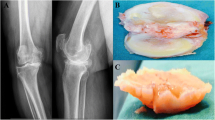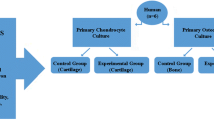Abstract
Chondrotoxicity is a rare toxicological finding which is observed in dogs after administration of quinolone antibacterials. To study this effect chondrocytes from articular cartilage of dogs were isolated, and incubated with quinolone derivatives. The effects on cell viability, mitochondrial dehydrogenase, and proteoglycan synthesis were determined. These results were compared with in vivo findings in dogs treated with these quinolones. It was concluded that inhibition of mitochondrial dehydrogenase activity and of proteoglycan synthesis are major reasons for cartilage damage. Therefore this in vitro model is capable of identifying strongly arthropathogenic quinolones without the need of performing animal studies.
Similar content being viewed by others
References
Amacher DE, Schomaker SJ, Gootz TD, McGuirk PR (1989) Proteoglycan and procollagen syntheses in rat embryo limb bud cultures treated with quinolone antibacterials. Alt Methods Toxicol 7: 307–312
Aydelotte MB, Greenhill RR, Kuettner KE (1988) Differences between subpopulations of cultured bovine articular chondrocytes. II. Proteoglycan metabolism. Connec Tissue Res 18: 223–234
Basleer C, Henrotin Y, Franchimont P (1990) In vitro assays of chondrocyte functions: the influence of drugs and hormones. Scand J Rheumatol Suppl. 81: 13–20
Burkhardt JE, Hill MA, Carlton WW, Kesterson JW (1990) Histologic and histochemical changes in articular cartilages of immature beagle dogs dosed with difloxacin, a fluoroquinolone. Vet Pathol 27: 162–170
Carmichael J, Mitchell JB, DeGraff WG, Gamson J, Gazdar AF, Johnson BE, Glatstein E, Minna JD (1985) Chemosensitivity testing of human lung cancer cell lines using the MTT assay. Br J Cancer 57: 540–547
Castora FJ, Vissering FF, Simpson MV (1983) The effect of bacterial DNA gyrase inhibitors on DNA synthesis in mammalian mitochondria. Biochim Biophys Acta 740: 417–427
Chin JE, Lin Y (1988) Effects of recombinant human interleukin-1b on rabbit articular chondrocytes. Arthritis Rheum 31 [10]: 1290–1296
Couchman JR, Caterson B, Christner JE, Baker JR (1984) Mapping by monoclonal antibody detection of glycosaminoglycans in connective tissue. Nature 307: 650–652
Gallagher M, Weinberg R, Simpson MV (1986) Effect of the bacterial DNA gyrase inhibitors, novobiocin, nalidixic acid, and oxolinic acid, on oxidative phosphorylation. J Biol Chem 261 [19]: 8604–8607
Goldberg RL, Kolibas LM (1990) An improved method for determining proteoglycans synthesized by chondrocytes in culture. Connec Tissue Res 24: 265–275
Hascall VC, Kimura JH (1982) Proteoglycans: isolation and purification. Methods Enzymol 82: 769–800
Ingham B, Brentnall DW, Dale EA, McFadzean JA (1977) Arthropathy induced by antibacterial fused N-alkyl-4-pyridone-3-carboxylic acids. Toxicol Lett 1: 21–26
Kato M, Onodera T (1988 a) Morphological investigation of cavity formation in articular cartilage induced by ofloxacin in rats. Fundam Appl Toxicol 11: 110–119
Kato M, Onodera T (1988b) Morphological investigation of osteochondrosis induced by ofloxacin in rats. Fundam Appl Toxicol 11: 120–131
Rapraeger A, Jalkanen M, Endo E, Koda J, Bernfield M (1985) The cell surface proteoglycan from mouse mammary epithelial cells bears chondroitin sulfate and heparan sulfate glycosaminoglycans. J Biol Chem 260 [20]: 11046–11052
Schlüter G (1987 a) Toxicology of quinolones. Fortschritte der antimikrobiellen und antineoplastischen Chemotherapie 6-10: 1631–1642
Schlüter G (1987 b) Ciprofloxacin: review of potential toxicologic effects. Am J Med 82 [Suppl. 4A]: 91–93
Stahlmann R (1988) Flouroquinolones — a new class of antimicrobial agents. Drugs of Today 24: 529–536
Stahlmann R (1990) Safety profile of the quinolones. J Antimicrob Chemother 26 [Suppl. D]: 31–44
Stahlmann R (1991) Knorpelschädigende Wirkung der Chinolone. Infection 19 [Suppl. 1]: S38-S46
Stahlmann R, Blankenburg G, Neubert D (1988) Studies on cartilage formation and differentiation in limb-bud culture in the presence of nalidixic acid, ofloxacin, and ciprofloxacin. Rev Infect Dis 10 [Suppl. 1]: S147
Zhang S, Lipsky MM, Trump BF, Hsu I (1990) Neutral Red (NR) assay for cell viability and xenobiotic-induced cytotoxicity in primary cultures of human and rat hepatocytes. Cell Biol Toxicol 6 [2]: 219–234
Author information
Authors and Affiliations
Rights and permissions
About this article
Cite this article
Hildebrand, H., Kempka, G., Schlüter, G. et al. Chondrotoxicity of quinolones in vivo and in vitro. Arch Toxicol 67, 411–415 (1993). https://doi.org/10.1007/BF01977402
Received:
Accepted:
Issue Date:
DOI: https://doi.org/10.1007/BF01977402




